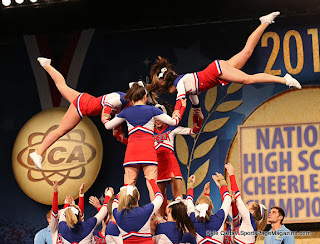There's always been a controversy in the athletic world about whether or not "cheerleading" should be considered a sport. It's high time we prove that being a cheerleader doesn't just consist of “clapping and yelling.” On the contrary, cheer is an intense and competitive
sport.

Cheerleaders have many different skills to obtain in this sport, making it more difficult than your average. Such skills include flexibility, endurance, and strength. Having these skills will make these athletes better in every aspect of cheer. Flexibility is required of our flyers; they're not able to pull a skill in the air without it. Endurance is required of every member of the team; without endurance, our cheerleaders would not be able to run around every inch of those 9 mats, throw their tumbling pass, and run straight to pyramid to hoist up another stunt. Strength comes from our bases. They have the strength to push a girl their size over their heads. One quote my cheer team loves to live by is "Athletes lift weights, cheerleaders lift athletes." When we compete, our routines are arduous and difficult to endure. We give everything we've got and leave it all on the mats. All of our endurance and adrenaline is used within those two and a half minutes.
 Cheer is proven a sport by the fact that it follows all guidelines and requirements of being an athletic activity. On Varsity's website, there's an article by Nicole Lauchaire that further proves the fact that Cheerleading qualifies as a sport. In that article, her claim is backed up with hardcore facts and evidence. "The Women's Sports Foundation has narrowed the field down of what is considered a sport to these elements that are commonly agreed upon to define a sport:
Cheer is proven a sport by the fact that it follows all guidelines and requirements of being an athletic activity. On Varsity's website, there's an article by Nicole Lauchaire that further proves the fact that Cheerleading qualifies as a sport. In that article, her claim is backed up with hardcore facts and evidence. "The Women's Sports Foundation has narrowed the field down of what is considered a sport to these elements that are commonly agreed upon to define a sport:- It must be a physical activity which involves propelling a mass through space or overcoming the resistance of mass. (Stunting… check)!
- “Contesting” or competing against/with an opponent is required (Competition… check)!
- It must be governed by rules that explicitly define the time, space, and purpose of the contest and the conditions under which a winner is declared. (Time limit, mat size, score sheets… check, check, check)!
- Acknowledgement that the primary purpose of the competition is a comparison of the relative skills of the participants. (You know those competitions on ESPN? Those are national championships… check)!"
 It's also been made clear that “any physical activity
in which relative performance can be judged or qualified can be
developed into a competitive sport as long as:
It's also been made clear that “any physical activity
in which relative performance can be judged or qualified can be
developed into a competitive sport as long as:1) The physical activity includes the above defined elements and…
2) The primary purpose is competition verses other teams or individuals within a competition structure comparable to other ‘athletic’ activities.”
You can find this article at: http://www.varsity.com/event/1262/being-a-cheerleader-sport
One of the best movie scenes to sum up the misconception of cheerleaders happens to be in the classic cheer flick: Bring it On.
Torrance: Ever been to a cheerleading competition?
Missy: Oh, you mean like a football game?
Torrance: No, not a game those are like practices for us. I'm talking about a tournament. ESPN cameras all around. Hundreds of people cheering.
Cliff: Wait a minute, people cheering... cheerleaders?
Torrance: That's right. Lots of people.
Pertaining to High School Cheer:
Not only do High School cheer teams have to worry about cheering at games, fundraising, and community service, these cheerleaders have to prepare for competitions "2-3 months in advance" says Tori Bohling. "We drill everything until it's perfect, blood sweat and tears go into every practice leading up to a competition" says Erin Mahler. Every practice for High School Cheerleaders are tough, 100% effort is always given. The Legacy Cheer team practices for 2 1/2 hours everyday after school, unless there's a game. Chase Montoya had said "I think it's crazy how much high school cheer practices; everyday. It's exhausting."
Competing at a high school level is in ways, much different from competing All-Star. With high school teams, you play with the cards you’re dealt meaning not every person on the team was a genetically engineered cheerleading professional. Although this is true, high school cheerleaders train just as hard, practice just as much, and do a lot more in their community. When asked the differences between High School and All-Star cheer, Kylie McBride, had said "All-Star cheerleaders don't have to worry about other things like community service and school activities." We as a team put in a lot of time and effort into our school and it's presentation.
To recap:
- Cheerleading qualifies as a sport- so that's what we're calling it.
- High School Cheerleaders work harder than most.
- Being a cheerleader in fact, doesn't just consist of “clapping and yelling.”
Interviewees:
Legacy Varsity cheerleader and three year veteran Tori Bohling (16)
Former Cheer Central cheerleader and current Legacy Varsity cheerleader Chase Montoya (18)
Former Cheer Central cheerleader and current Legacy Varsity cheerleader Kylie McBride (15)
Legacy Varsity cheer co-captain and three year veteran Erin Mahler (16)
This is awesome! I am only taking points off because it it late. Great post!
ReplyDelete